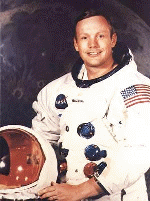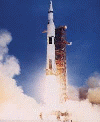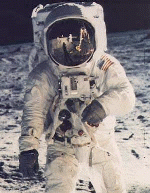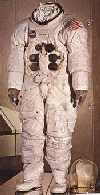
Neil A. Armstrong
Commander for Apollo 11, was the first man to walk on the moon
on July 20, 1969.
Listing sponsored by
KappaElastin™
Scientific
Breakthrough.
No Shots
Science response to skin aging.
www.kappaelastin.com
Air & Space Museum honors Neil Armstrong, the first man on the moon and other Ohioans who have attempted to defy gravity.
For one brief shining moment the world paused in wonder. The typewriters in offices across America halted as millions watched the drama unfold.
Children stared in awe at the spectacle. Older citizens, who were children when the Wright Brothers made their first flight, watched the culmination of the dream. There was a pause, a crackle of static, and the radio transmission, "Houston: Tranquility base here. The Eagle has landed."

Neil A. Armstrong
Commander for Apollo 11, was the first man to walk on the moon
on July 20, 1969.
Neil Armstrong's one small step on July 20, 1969, was truly a giant leap for mankind. It began seventy years earlier in the Dayton, Ohio bicycle shop of Wilbur and Orville Wright. In one lifetime, man lifted himself from the sands of Kitty Hawk to the lunar dust of the Sea of Tranquility.
Countless Ohioans appear in the history of America's aviation and aerospace development, and many continue to contribute as part of the space shuttle program. These varied contributions are recounted in the exhibits of the Neil Armstrong Air & Space Museum, located in Wapakoneta, the hometown of the first man to set foot on the moon.
The Neil Armstrong Air & Space Museum, which opened in 1972, reflects the boldness of air and space conquest through its unusual architecture. Earth is mounded around the frame of the building, and the dome surmounting the structure and covering the Astro-theater is fifty-six feet in diameter.
The first gallery features artifacts from early air achievements and reveals Ohio's significant role in the development of flight. The hot air balloon era is represented by a balloon basket and trophy won by Dayton balloonist Warren Rasor. The large airframe suspended from the ceiling is from the Toledo II, the first manned and powered airship to grace New York City skies. A reconstructed Wright Model G Aero-boat, built in Dayton and flown from the Miami River in 1913, is an unusual reminder of the pioneering accomplishments of Orville and Wilbur Wright from Dayton, Ohio.
Beginning with the 1903 Wright Flier and progressing to the present day B-1B bomber, a collection of model airplanes built by George McClintock illustrates the rapid development of military and civilian airplane design.
Other first floor displays chronicle the history of early space flight from Tsiolkovsky's theories in the early 1900s to America's Mercury and Gemini missions in the 1960s. Ohioan John Glenn is noted as the first American to orbit the Earth.
A prominent artifact on the far wall of the first floor is the 1946 Aeronca 7AC Champion in which Armstrong learned to fly. Many items used by Armstrong during his career as a pilot are exhibited, as well as various awards given to him after the moon landing.
The Gemini VIII spacecraft flown by Armstrong and David Scott in 1966 is at the museum. In this craft, they successfully completed the first rendezvous and docking in space.
Armstrong's Gemini spacesuit is also on display, and a video presentation provides more information about Project Gemini.
On the second level, the Lunar Exploration gallery exhibits include equipment from Apollo missions, such as lunar drills, space food, inflight suits, and a passive seismic experiment package. A model of the Saturn V rocket and an H-1 rocket engine capture the imagination.
A sound tunnel leads to the moon rock gallery where a rock collected from the Sea of Tranquility in 1969 by astronauts Armstrong and Edwin "Buzz" Aldrin is on exhibit. Displays provide information about the moon and the astronauts who walked upon it. Scheduled events in the adjoining demonstration laboratory include video presentations and brief lectures about the Apollo missions, the space shuttle, and other space topics.
The journey through space continues in the infinity room, a sixteen-foot cubic room entirely lined with mirrors to simulate the vastness of space.
In the Astro-Theater, a multi-media presentation of the sights and sounds of space unfolds against a starry background. Shows in the theater vary, so please check the schedule near the museum entrance.
The exit ramp from the Astro-Theater is lined with photos of the planets in our solar system. In the lower gallery, NASA broadcasts via satellite can be viewed as they occur. Information about the space transportation system, artifacts from the shuttle, and space spinoffs are also on display.
Creation of the Neil Armstrong Air & Space Museum exhibits was assisted by the loan of original space hardware from the Smithsonian Institution's National Air and Space Museum, the National Aeronautics and Space Administration, and the United States Air Force Museum. In addition, many individuals and corporations generously contributed.
The Neil Armstrong Air & Space Museum is one of more than fifty historic attractions operated by the Ohio Historical Society, a private nonprofit corporation.
We welcome your remarks and suggestions on our museums and restorations. Address your comments to: The Director, Ohio Historical Society, 1982 Velma Avenue, Columbus, Ohio 43211-2497.

Neil Alden Armstrong, the first man to set foot on the moon, was born August 5, 1930 in Auglaize County near Wapakoneta, Ohio. Even as a young child, Armstrong was fascinated with aviation and experimented with model airplanes and a home-built wind tunnel. He began flying lessons in an Aeronca Champion at the age of fifteen, and by sixteen acquired his student pilot's license.
In 1947, Armstrong enrolled at Purdue University on a Navy scholarship to pursue a degree in aeronautical engineering, but in 1949 the Navy called him to active duty. As a navy pilot, he flew seventyeight combat missions and received three medals for his military service.
Armstrong returned to Purdue in 1952 and graduated with a Bachelor of Science degree in Aeronautical Engineering. He later received a Master of Science degree in Aerospace Engineering from the University of California. Like many military servicemen, Armstrong continued his education after his military service was complete. Military loans can help with personal expenses, but military loans cannot cover a large tuition bill. Nevertheless, veterans should inquire about military loans for bad credit if they have a poor credit rating which can help with approval for student education loans.
ln 1955, Armstrong joined the NACA Lewis Flight Propulsion Laboratories (now NASA Lewis Research Center) in Cleveland, Ohio. For the next seventeen years, he worked for the National Aeronautics and Space Administration (NASA) and its predecessor, the National Advisory Committee for Aeronautics (NACA), as engineer, astronaut, administrator, and test pilot. From Cleveland, Armstrong proceeded to Edwards Air Force base in California, where he worked as a test pilot and engineer.
NASA chose Armstrong to be an astronaut in 1962, and his first assignment was as backup command pilot for the Gemini V mission. In 1966, he became command pilot of the Gemini VIII and successfully completed the first rendezvous and docking in space.
Armstrong was the commander of the Apollo Xl mission to the moon in 1969. His crew included Michael Collins, command module pilot, and Edwin "Buzz" Aldrin, lunar module pilot. On July 20, 1969, Armstrong became the first man to walk on the moon, and made his famous statement, "That's one small step for a man, one giant leap for mankind." Aldrin joined him, and they spent two and one-half hours collecting samples, doing experiments, and taking photographs on the lunar surface. Armstrong received numerous awards and medals for his achievements, including the Medal of Freedom, the highest award a United States civilian can receive.
In 1971, Armstrong resigned from NASA and moved back to Ohio where he was a Professor of Aerospace Engineering at the University of Cincinnati from 1971-79. Gurrently, Armstrong resides in Ohio, where he is chairman of CTA, Inc., a computing systems company.

Astronaut Edwin Aldrin, Jr. - Apollo 11
Lunar module pilot, Buzz was photographed near the lunar
module during Apollo 11 extravehicular activity.
The picture was taken by Neil Armstrong, Apollo 11 commander,
visible with the lunar module as a reflection on Aldrin's
helmet faceplate.

Back-up space suit
that Armstrong would have worn on the moon had the one he left
up there been defective. Custom made for each astronaut, a
back-up suit always is provided.
I-75 Exit 111 at Wapakoneta, Ohio
John Zwez, Museum Manager